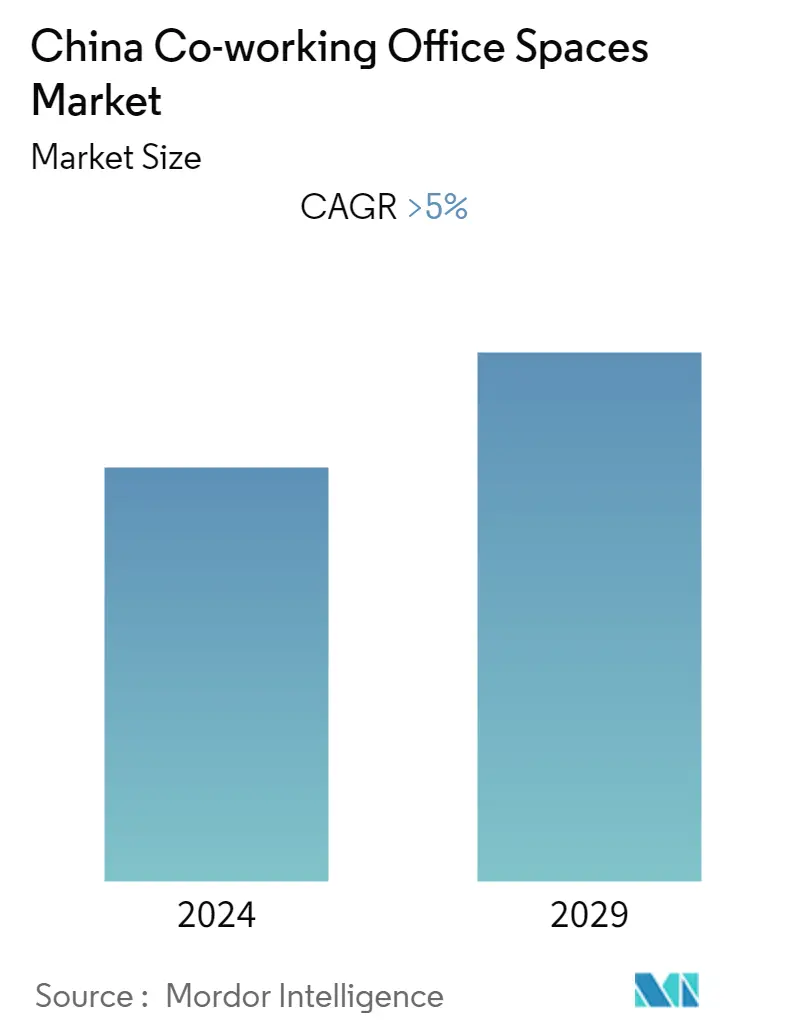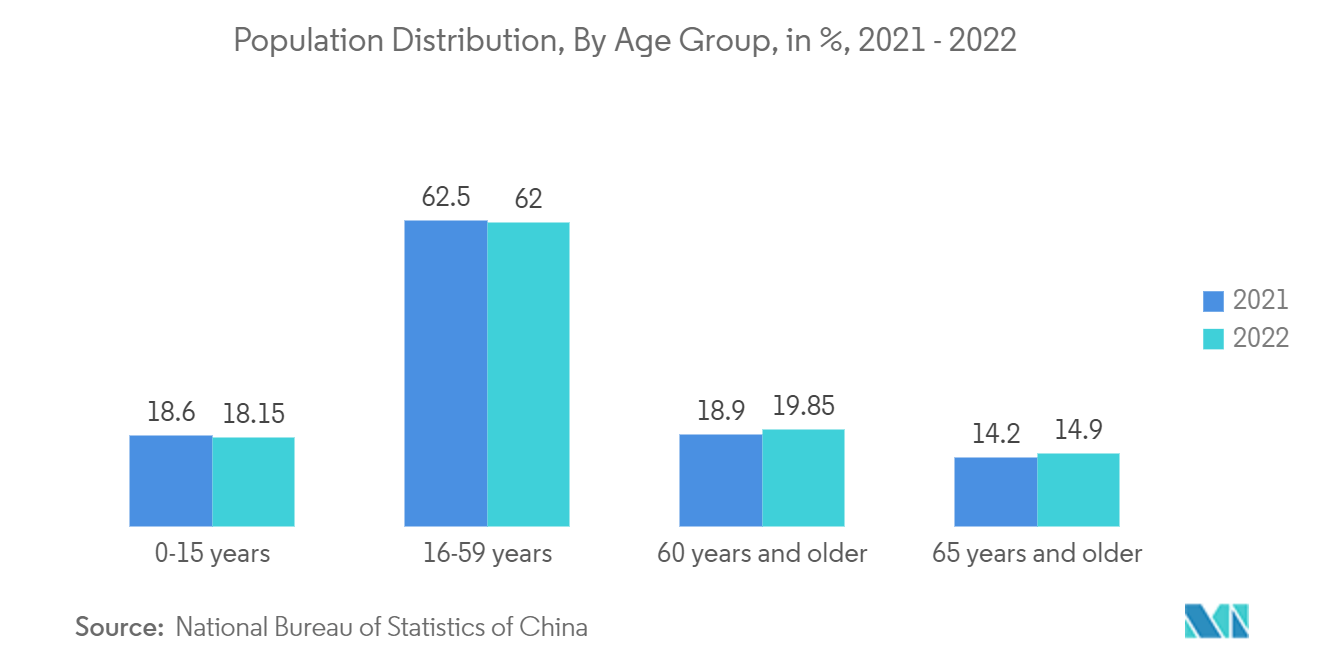China Co-Working Office Space Market Size

| Study Period | 2019 - 2029 |
| Base Year For Estimation | 2023 |
| Forecast Data Period | 2024 - 2029 |
| Historical Data Period | 2019 - 2022 |
| CAGR | 5.00 % |
| Market Concentration | Medium |
Major Players
*Disclaimer: Major Players sorted in no particular order |
China Co-Working Office Space Market Analysis
The Chinese Co-working Office Spaces Market is anticipated to record a CAGR of more than 5% during the forecast period.
- The COVID-19 pandemic accelerated the growth of co-working spaces in the country, as traditional workspaces faced challenges during the crisis. Many enterprises moved toward co-working spaces because of the affordable prices and flexibility. The co-working spaces provided a safe working environment.
- The sector is driven by increasing demand from small and medium enterprises (SMEs), freelancers, and start-ups. Large-scale enterprises are also adopting co-working spaces due to their benefits, such as top facilities at affordable prices-also, the increasing number of start-ups with a high investment flow rate results in robust sector growth.
- More mainland Chinese landlords are expected to enter Hong Kong's flexible working space, which has historically been controlled by domestic and foreign investors because it provides a low-risk entry point into the larger office market. China Resources, a mainland-based company, built the CRB Business Lounge in Wan Chai in October, providing 24-hour access to fully furnished, flexible workspaces. Landlord-operated co-working spaces have been controlled by big local operators such as Hongkong Land, Great Eagle Holdings, Swire Properties, and Henderson Land Development. Moreover, China has more than 300 co-working offices contributing 1.48% to the global share of the co-working office spaces market.
China Co-Working Office Space Market Trends
This section covers the major market trends shaping the China Co-working Office Space Market according to our research experts:
Increasing Demand for Co-Working Spaces to Support Growth
The co-working office spaces have been significantly growing over the years. In 2021, Beijing and Guangzhou led the sector by offering many co-working spaces. Beijing remained a significant location in the country, with most businesses moving to co-working and shared offices. Beijing was followed by Wuhan, the second-largest co-working market in China with shared offices, attracting a wide range of tenants, including major corporates, government organizations, and start-ups.
Most freelancers, start-ups, and small and medium-scale enterprises (SMEs) adopt co-working spaces. These spaces provide top features and facilities such as fast internet services, 24/7 access to office space, meeting rooms, and furnished and unfurnished spaces. Serviced offices (creative and classic) contribute most of the share in the co-working office space sector.
Even though China's SME sector is growing moderately, the rising cost of business operations, including the high rental cost of commercial properties, is influencing many upcoming small businesses to look for cost-effective alternatives. This factor created new opportunities for co-working service providers to accommodate small business owners. As a result, China is witnessing a massive boom in the co-working culture, with many co-working spaces coming up across the country.

The Growing Millennial Population Boosting the market
Millennials (currently aged between 20 and 37) are changing how the world works and demanding new ways of working. The Chinese real estate sector is focusing on the changing work culture. The 400 million millennials in China constitute a big and expanding consumer generation with enormous economic influence. High-end brands are popular among millennials. They will account for 40% of luxury goods sales by 2024, according to a source, with 50% of that age group between the ages of 18 and 30. Here are some important insights on the Chinese consumer of 2022.
Co-working spaces are a new trend of working that emerged recently. Co-working spaces are shared environments where people doing different jobs can work together and separately within the same space. The spaces are often very urban and stylish and are far removed from some of the more severe 'cubicle farms' of recent times. They allow for freedom, flexibility, and various work environments.
More millennials are joining the workforce, and their presence requires a transformational shift in the workplace perspective. There are 14,000 functional co-working spaces globally. By the end of this year, around 1.7 million people (mostly millennials) will likely take advantage of the new working conditions offered by co-working spaces. According to industry sources, as of 2021, there were more than 350 millennials in China aged between 25 and 54, representing the new workforce with bold new ideas.

China Co-Working Office Space Industry Overview
The Chinese co-working office spaces market is moderately fragmented, with many international and national players. The demand for co-working spaces after the COVID-19 pandemic attracted many people to the market and made it competitive. The prominent established players are mainly focusing on expansion and M&A activities.
Some of the top players in the market are WeWork, Regus, Servcorp, CoWorker, and Ucommune. Many new players are entering the market as it is a rapidly growing market.
China Co-Working Office Space Market Leaders
-
CoWorker
-
WeWork
-
ServCorp
-
Regus
-
People Squared
*Disclaimer: Major Players sorted in no particular order

China Co-Working Office Space Market News
- January 2023: The General Services Administration (GSA) and cloud cyber giant Cisco launched a new hybrid workspace option for federal employees. The couple just launched the GSA's new Workplace Innovation Lab, a coworking facility for federal government employees. The 25,000-square-foot building includes conference rooms, common collaboration space, and six suites of offices. Along with Cisco, the GSA launched the Workplace Innovation Lab in collaboration with Allsteel, Haworth/Price Modern, Miller-Knoll, Kimball International, and Swiftspace/VOE.
- March 2022: WeWork announced a partnership with Currys and introduced a new hybrid working policy. The new hybrid working policy is for the corporate and commercial sectors. Currys will equip its 1,000+ corporate workforce with WeWork.
China Co-Working Office Space Market Report - Table of Contents
1. INTRODUCTION
- 1.1 Study Deliverables
- 1.2 Study Assumptions
- 1.3 Scope of the Study
2. RESEARCH METHODOLOGY
3. EXECUTIVE SUMMARY
4. MARKET INSIGHTS AND DYNAMICS
- 4.1 Market Overview
- 4.2 Market Drivers
- 4.3 Market Restraints
- 4.4 Value Chain / Supply Chain Analysis
-
4.5 Industry Attractiveness - Porter's Five Force Analysis
- 4.5.1 Threat of New Entrants
- 4.5.2 Bargaining Power of Buyers/Consumers
- 4.5.3 Bargaining Power of Suppliers
- 4.5.4 Threat of Substitute Products
- 4.5.5 Intensity of Competitive Rivalry
- 4.6 Government Regulations and Initiatives
- 4.7 Technological Trends
- 4.8 Brief on Rental Analysis of Flexible Office Spaces
- 4.9 Insights on Co-working Start-ups in China
- 4.10 Impact of COVID-19 on the Market
5. MARKET SEGMENTATION
-
5.1 By Type
- 5.1.1 Flexible Managed Office
- 5.1.2 Serviced Office
-
5.2 By Applications
- 5.2.1 Information Technology (IT and ITES)
- 5.2.2 Legal Services
- 5.2.3 Consulting
- 5.2.4 BFSI (Banking, Financial Services, and Insurance)
-
5.3 By End User
- 5.3.1 Personal User
- 5.3.2 Small-scale Company
- 5.3.3 Large-scale Company
-
5.4 By Geography
- 5.4.1 Shanghai
- 5.4.2 Beijing
- 5.4.3 Wuhan
6. COMPETITIVE LANDSCAPE
- 6.1 Market Concentration Overview
-
6.2 Company Profiles
- 6.2.1 Servcorp
- 6.2.2 WeWork
- 6.2.3 PeopleSquared
- 6.2.4 Coworker
- 6.2.5 Regus
- 6.2.6 Kr Space
- 6.2.7 MydreamPlus
- 6.2.8 Ucommune
- 6.2.9 Cowork Booking
- 6.2.10 Atlas*
- *List Not Exhaustive
7. MARKET OPPORTUNITIES AND FUTURE TRENDS
8. APPENDIX
** Subject To AvailablityChina Co-Working Office Space Industry Segmentation
Co-working spaces refer to working arrangements where people from different teams and companies work in a shared space. A co-working space is characterized by shared facilities, services, and tools. Co-working is an arrangement in which workers of different companies share an office space, allowing cost savings and convenience using common infrastructures.
The China co-working office spaces market is segmented by type (flexible managed office and serviced office), application information technology (IT and ITES), legal services, BFSI (Banking, Financial Services, and Insurance), consulting, and other services), by end-user (personal user, small scale company, large scale company, and other end users), by geography (Shanghai, Beijing, Wuhan, and other key cities). The report offers market size and forecasts in value (USD billion) for all the above segments.
| By Type | Flexible Managed Office |
| Serviced Office | |
| By Applications | Information Technology (IT and ITES) |
| Legal Services | |
| Consulting | |
| BFSI (Banking, Financial Services, and Insurance) | |
| By End User | Personal User |
| Small-scale Company | |
| Large-scale Company | |
| By Geography | Shanghai |
| Beijing | |
| Wuhan |
China Co-Working Office Space Market Research FAQs
What is the current China Co-working Office Spaces Market size?
The China Co-working Office Spaces Market is projected to register a CAGR of greater than 5% during the forecast period (2024-2029)
Who are the key players in China Co-working Office Spaces Market?
CoWorker, WeWork, ServCorp, Regus and People Squared are the major companies operating in the China Co-working Office Spaces Market.
What years does this China Co-working Office Spaces Market cover?
The report covers the China Co-working Office Spaces Market historical market size for years: 2019, 2020, 2021, 2022 and 2023. The report also forecasts the China Co-working Office Spaces Market size for years: 2024, 2025, 2026, 2027, 2028 and 2029.
Shared Office in China Industry Report
Statistics for the 2024 Shared Office in China market share, size and revenue growth rate, created by Mordor Intelligence™ Industry Reports. Shared Office in China analysis includes a market forecast outlook 2029 and historical overview. Get a sample of this industry analysis as a free report PDF download.



